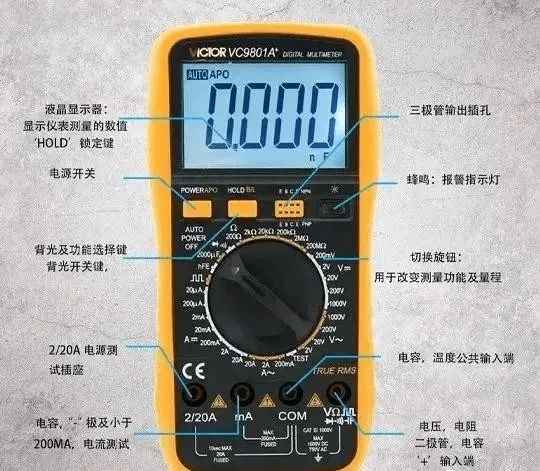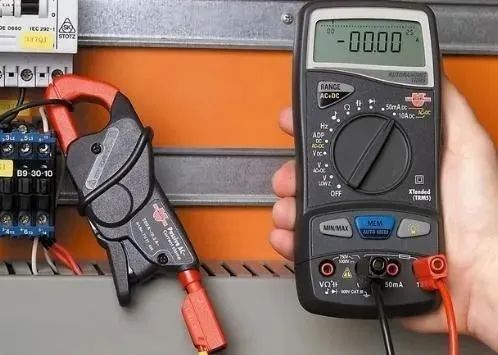 Search on WeChat
Search on WeChat Technical TrainingA multimeter, also known as a multi-tester, is a versatile measuring instrument that can measure DC current, DC voltage, AC voltage, resistance, and audio levels. Some models can also measure AC current, capacitance, inductance, and certain parameters of semiconductors. It is a commonly used tool for electricians.
Technical TrainingA multimeter, also known as a multi-tester, is a versatile measuring instrument that can measure DC current, DC voltage, AC voltage, resistance, and audio levels. Some models can also measure AC current, capacitance, inductance, and certain parameters of semiconductors. It is a commonly used tool for electricians.

1. Check the range before measuring; do not measure without checking.
Every time you pick up the probes to measure, make sure to double-check that the measurement category and range selection switch are set correctly. For safety, this habit must be developed.
2. Do not change the range while measuring; switch to the empty range after measuring:
Do not arbitrarily turn the selection knob during measurement, especially when measuring high voltage (like 220V) or large current (like 0.5A), to avoid generating an arc that could damage the switch contacts. After measuring, switch the range selection to the “?” position.
3. The dial should be level, and the reading must be aligned.
When using a multimeter, it should be rotated to a level position, and your line of sight should be directly aligned with the needle when reading.
4. The range must be appropriate; the needle should deflect more than half.
When selecting a range, if you cannot estimate the size of the measurement beforehand, try to select a larger range first, then gradually switch to a smaller range based on the deflection angle until the needle deflects to about 2/3 of the full scale.
5. Measure resistance without power; discharge capacitors before measuring capacitance.
It is strictly forbidden to measure resistance in a powered circuit. When checking large capacitors in electrical equipment, discharge the capacitor before measuring.
6. Zero the meter before measuring resistance; adjust to zero when changing ranges.
When measuring resistance, first turn the switch to the resistance range, short the two probes, and adjust the “Ω” zero potentiometer until the needle points to zero ohms before measuring. Each time you change the resistance range, you should readjust the ohm zero point.
Measuring AC Voltage
Select the AC range on the switch, ensuring the unit matches the requirements;
Connect the probes across the circuit, ensuring the positive and negative polarities are correct;
When measuring high voltage, change the socket; do not forget to switch off the power before changing the range;

Precautions for Using a Multimeter
When using an analog multimeter, connect one end of each probe according to the requirement of red for positive (+) and black for negative (-) at the measurement end, then confirm that the needle is at the “0” position. The needle should align with the left end line of the scale; if not, zero adjustment is necessary. Before measuring current and voltage, estimate the expected range and set it to a larger range first, then adjust to the appropriate range to avoid burning out the multimeter due to excessive current.
During measurement, consider the impact of the multimeter’s internal resistance. For example, to measure voltage, when the probes are connected to the circuit, current also flows through the multimeter’s internal resistance, which affects the measurement value. When measuring the voltage at the same point using different ranges, the internal resistance of the multimeter varies, affecting the measurement differently.
When measuring transistor circuits, it is better to select a DC range with an internal resistance of 20kΩ/V, which is usually marked on the multimeter’s scale. Additionally, transistor circuits often require measuring low voltages, such as 0.1V, so the selected multimeter should have a measurement range of 1V.
Disclaimer: This article is reproduced from the internet, and the copyright belongs to the original author. If there are any copyright issues, please contact us for deletion. Thank you!
HISTORY/Previous Recommendations
Complete question bank for the 2021 electrician beginner exam (including answers)
3 essential tools for electricians, easily accessible via WeChat!
Ten-year veteran electrician’s “pathway” to earning over ten thousand a month!
Five major electrical drawing software (CAD, Eplan, CADe_simu…), which one do you pick?
Latest electrical CAD drawing software, with a detailed installation tutorial!
Latest electrical drawing software EPLAN, with a detailed installation tutorial!
Common issues for beginners using S7-200 SMART programming software (with download link)
Comprehensive electrical calculation EXCEL sheets, automatically generated! No need to ask for electrical calculations!
Bluetooth headphones, electrician/PLC introductory books available for free? Come and claim your electrical gift!
Basic skills in PLC programming: Ladder diagrams and control circuits (with 1164 practical Mitsubishi PLC cases)
Still can’t understand electrical diagrams? Basics of electrician diagram reading, simulation software available for quick practical learning!
12 free electrician video courses, 10GB of software/e-books, and 30 days of free electrician live classes are available for free!
Don’t forget to like and share!
 Click “Read the original text” to learn PLC/electrician courses for free.
Click “Read the original text” to learn PLC/electrician courses for free.